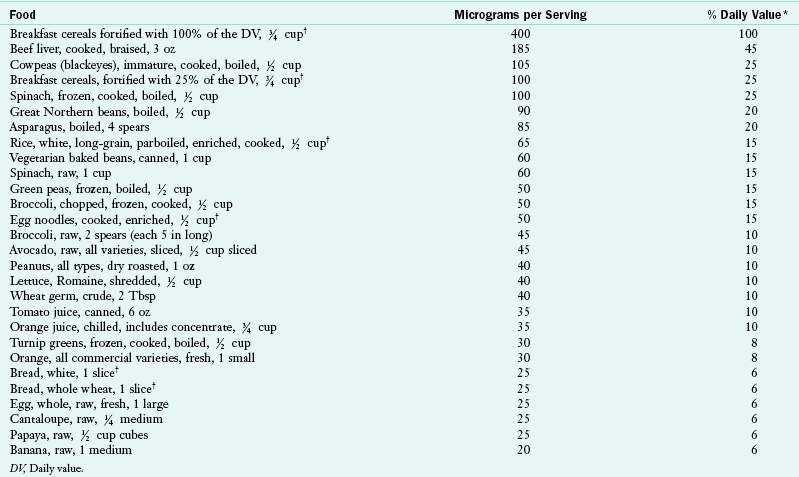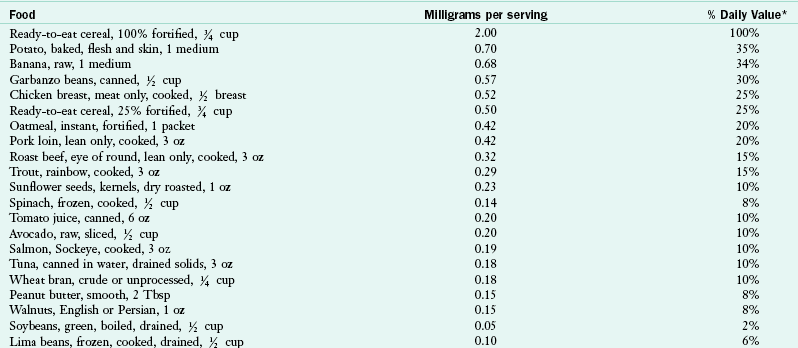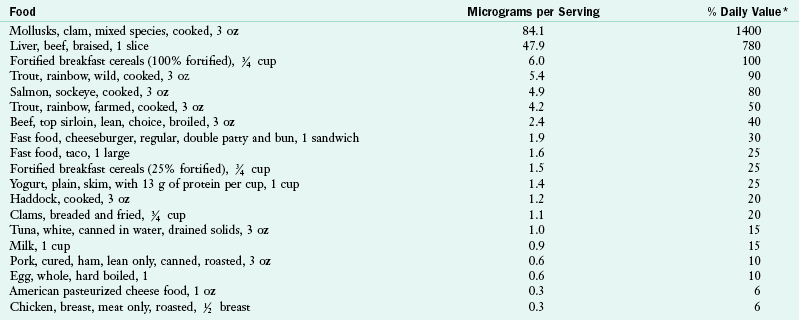Nutritional Facts on Folic Acid, Vitamin B6, and Vitamin B12
Folate is a water-soluble B vitamin that occurs naturally in food. Folic acid is the synthetic form of folate that is found in supplements and added to fortified foods. Folate or folic acid helps produce and maintain new cells, which is especially important during periods of rapid cell division and growth such as infancy, adolescence, and pregnancy. Folate is needed to make deoxyribonucleic acid (DNA) and ribonucleic acid, the building blocks of cells. It also helps prevent changes to DNA that may lead to cancer. Both adults and children need folate to make normal red blood cells and prevent anemia. Folate is also essential for the metabolism of homocysteine and helps maintain normal levels of this amino acid.
Selected Food Sources of Folate and Folic Acid

*DVs are reference numbers based on the recommended dietary allowance. They were developed to help consumers determine if a food contains a lot or a little of a specific nutrient. The DV for folate is 400 mcg. The %DV listed on the Nutrition Facts panel of food labels states the percentage of the DV provided in one serving.
†Fortified with folic acid as part of the Folate Fortification Program.
Vitamin B6
Vitamin B6 is a water-soluble vitamin that exists in three major chemical forms: pyridoxine, pyridoxal, and pyridoxamine and performs a wide variety of functions in the body. It is needed for more than 100 enzymes involved in protein metabolism and is essential for red blood cell metabolism. The nervous and immune systems need vitamin B6 to function efficiently, and it is also needed for the conversion of tryptophan (an amino acid) to niacin. A vitamin B6 deficiency can result in a form of anemia that is similar to iron deficiency anemia.
Through its involvement in protein metabolism and cellular growth, vitamin B6 is important to the immune system. It helps maintain the health of lymphoid organs (thymus, spleen, and lymph nodes) that make white blood cells. It is also important for maintaining normal blood glucose levels.
Selected Food Sources of Vitamin B6

*Daily values (DVs) are reference numbers based on the recommended dietary allowance. They were developed to help consumers determine if a food contains a lot or a little of a specific nutrient. The DV for vitamin B6 is 2 mg. The %DV listed on the Nutrition Facts panel of food labels states the percentage of the DV provided in one serving.
Vitamin B12
Along with folate and vitamin B6, vitamin B12 is helpful in lowering the level of the amino acid homocysteine in the blood. It has been hypothesized that at high levels homocysteine might damage coronary arteries or make it easier for blood-clotting cells to clump together and form a clot. This could increase risks for a heart attack or stroke.
Vitamin B12 is a member of the vitamin B complex. It contains cobalt; thus it is also known as cobalamin. It is exclusively synthesized by bacteria and is found primarily in meat, eggs, and dairy products. There has been considerable research into proposed plant sources of vitamin B12. Fermented soy products, seaweeds, and algae (spirulina) have all been suggested as containing significant B12. However, the present consensus is that any B12 present in plant foods is likely to be unavailable to humans; thus these foods should not be relied on as safe sources. Many vegan foods are supplemented with B12.
Vitamin B12 is necessary for the synthesis of red blood cells, the maintenance of the nervous system, and growth and development in children. Deficiency can cause anemia. Vitamin B12 neuropathy, involving the degeneration of nerve fibers and irreversible neurologic damage, can also occur. Vitamin B12 can be stored in small amounts by the body. Proper vitamin B12 absorption requires the presence of intrinsic factor, which tends to diminish with aging. Total body store is 2 to 5 mg in adults. Approximately 80% of this is stored in the liver.
Selected Food Sources of Vitamin B12

*Daily values (DVs) are reference numbers based on the recommended dietary allowance. They were developed to help consumers determine if a food contains a lot or a little of a specific nutrient. The DV for vitamin B12 is 6 mcg. The %DV listed on the Nutrition Facts panel of food labels states the percentage of the DV provided in one serving.


